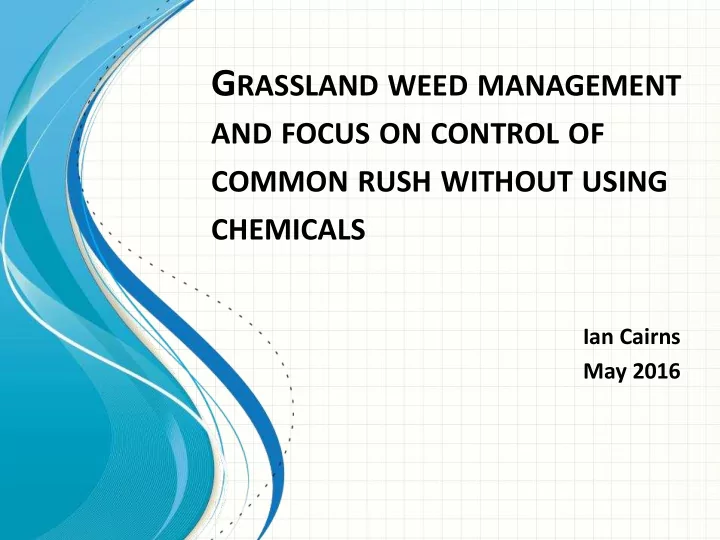

G RASSLAND WEED MANAGEMENT AND FOCUS ON CONTROL OF COMMON RUSH WITHOUT USING CHEMICALS Ian Cairns May 2016
Reversion of ‘improved’ marginal grassland – it’s a natural process! • Over time, quality and productivity deteriorates – Drainage less effective – Increase in soil acidity – Nutrient levels fall – Productive sward less competitive (more weeds – e.g. common rush an indicator?) • Less grass, less clover, lower silage yield, supports fewer LSU, slower stock growth rates • Expensive to improve – economically viable return?
Grassland weed associations • Wet soils • Dry soils • Low fertility • High fertility • Poor competition from grass sward • Disturbed soil/following reseeding
Grassland weed associations (examples) • Wet soils* (Common Rush, Creeping Buttercup, Bog Asphodel, Sphagnum Moss) • Dry soils (Bracken) • Low fertility (Silverweed, Yellow Rattle, Common Orchid) • High fertility (Docks & Nettles) • Disturbed soil/following reseeding (Chickweed, Red Dead Nettle) • Poor competition from grass sward (Any of the above)
Maintaining/improving productivity • What are your land management objectives? Before improvement consider: 1. Is permission required? 2. Habitat management under agri- environment schemes 3. Cost/benefit of improvement 4. Practicality of improvement 5. Living with less productive fields/part fields
Land improvement strategy – marginal/crofting Productive inbye Management Strategies Enclosed Improvements Natural disadvantage: wet or over 70% rush cover
Short term vs. long term control
Mechanical topping 4 stages 1. Graze hard to leave target weed standing above grass 2. Apply nutrients (if available/appropriate) 3. Top weeds at height above grass ‘crowns’ 4. Use livestock grazing to manage the regrowth
Competition from sward Soil Fertility & pH Drainage
Role of good grazing management in weed control • Avoid excess winter grazing • Reduce risk of poaching (cross compliance issue in 2015) • Reduce risk of winter kill in sward • Graze hard in the late spring/summer (prevent dominant weed growth)* • Cattle are better – less selective grazers and trampling (browsers are best!) • Use topping for management in summer
Common Rush - Context • Problem of permanent pasture & rough grazings - Greater problem in: – Poorly drained soils – High rainfall areas – Uncompetitive swards • Dense, deep rooting clumps reduce grazing value of productive sward • Huge volume of seeds produced – some lying dormant in the soil for decades • Farm specific management strategy – driven by objectives
Option Benefits Limitations Baling and removing Clean cut close to ground Need stone free and level No trash on surface surface Use as bedding material? Too much soil damage in wet conditions Chemical destruction N/A Prohibited in organic system Topping & left in-situ Low cost Mulch remains Equipment available to most Probably too much for rotary farmers topper. Window of opportunity in Limited by stones, drains, conjunction with frost? uneven terrain Burning No trash remains Habitat/wildlife damage Reduced rush seed viability Safety issues Fertile ash Ploughing in Too much trash to plough
Improving grass productivity • Liming and fertilising alone • Surface seeding – Direct drilling – Slot seeding – Tined harrow seeding – Broadcasting • Reseeding – ultimate control strategy? – Deep Ploughing – Light surface cultivation and firming – Sowing competitive seed mixture – Rolling to consolidate
Example Upland Seed Mixture Type % Hybrid Ryegrass 6.67 Early Perennial Ryegrass 10.00 Intermediate Perennial Ryegrass 13.33 Late Perennial Ryegrass AberBite (T) 41.33 Timothy 13.33 S S Meadow Grass 2.67 Creeping Red Fescue 6.67 White Clover 6.00
Assess soil structure to identify any problems
Drainage • Some soil types more susceptible to problems – High content of clay – High peat content – Very deep or very shallow soils • Damage to field drainage systems – Outfalls – Open drains – Clay and plastic systems • Damage to soil structure – Poaching by livestock – Machinery & cultivation
Soil fertility Address underlying problems: 1. Soil acidity (pH) 2. Soil nutrient status (P, K, Mg) Starts with soil analysis!
Soil fertility • Grass needs to be favoured by soil and growing conditions – pH 6.0 or higher on a mineral soil – Free draining soil – P & K & Mg – target index Moderate or above • Liming and nutrient application needs to promote grass growth – Types of liming material – Muck & slurry – ‘fertilisers’
Nutrient availability in the soil
Recommend
More recommend